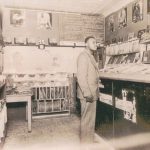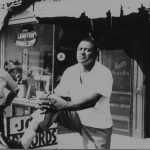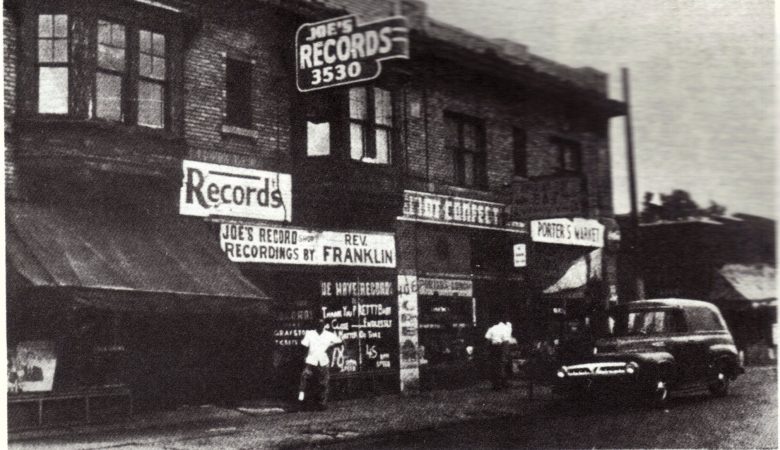In 1945, two years after the 1943 race riots in which Hastings Street was ravaged by Whites in pitched street battles, my father, Joe Von Battle – a seminal figure in Detroit music – opened Joe’s Record Shop on Hastings Street, the commercial thoroughfare of residential Black Bottom. Until recent years, many had no idea where Black Bottom was, or what it looked like – for there were few known images of the community. In a 2012 essay, I likened it to a mythical place of legend – Detroit’s Atlantis. I speak of it as hallowed ground.
Black Bottom was razed and the land eventually became Lafayette Park, though relegated to the forgotten past for some, it is remembered by academics, historians, and Detroiters – near and far – who lived, worked, or worshipped there. Some remember it as a place, in its latter years, that they were not allowed to visit. Many recall it vividly; some with shame, most with pride, and some with a mixture of both – often depending upon the era of their remembrances.
My father recorded many Detroiters including Kenny Burrell, Little Sonny, John Lee Hooker, and the Rev. C. L.

JOE VON BATTLE IN HIS RECORD SHOP, IN 1945, FROM A POSTCARD. MARSHA MUSIC/FAMILY COLLECTION
Franklin – and was the first to record Franklin’s daughter, Aretha, cutting her first gospel albums. The record shop with a studio in the back was on Hastings and Elliot, just south of Mack (now the southbound service drive at Mack and I-375). Although I was neither born nor did I ever live in Black Bottom – at least not prior to its existence as Lafayette Park – I have become publicly associated therewith, due to my writings and presentations on my father’s life and times. There are others who have preceded me in the telling of the stories of Black Bottom – my father’s oldest son, Joe Von Battle Jr., whose memories are the core of my work; journalist Sharon Sexton and her film, Black Bottom and Paradise Valley, The Forgotten Legacy; Bert Dearing, who preserves the history and energy of Black Bottom in the Eastern Market; and the venerable king of Black Bottom History, nonagenarian Jiam Desjardins – all expert in their knowledge and experience.
Most Blacks from Detroit, no matter how far-flung, have familial roots in Black Bottom; the same for many others – especially Whites with immigrant origins in Detroit. Often, they are aware of the streets on which their forebears lived after coming to America, but some have had no idea, until recent public discourse, that their relatives, in fact, dwelled in Black Bottom. Black Bottom was intensely diverse in the early last century, from the synergistic relationships between Blacks and Jews – both contentious and mutually dependent – to the first temple of the Nation of Islam, on Hastings. Black residents often spoke many of the languages around them.
Some paint a picture of Black Bottom as a mere cauldron of ill-repute. One wonders as to the persistence of this pernicious narrative, that denies the reality that the community included all manner of vagaries and triumphs of living, especially in its days of decline. The city’s Official Historian, Jamon Jordan, calls Black Bottom “the most culturally significant community in Michigan,” though never an officially designated neighborhood. Historian Ken Coleman notes the boundaries of Congress-Larned South, Gratiot North, Grand Trunk Railroad-Dequindre Cut East, and Hastings West. That is the greenspaces of Lafayette Park – north and south of Lafayette – and the Mies van der Rohe-designed high rises and townhouses, the core of Black Bottom-Lafayette Park.
However, as often happens in social migration, the boundaries expanded as the population grew after the 1920’s and – especially in colloquial reference and collective memory – folks all the way to Jefferson, past Eastern Market to Mack, way eastward to Mt. Elliot, often claim Black Bottom as home. My father’s store was regarded as a part of Black Bottom, by this latter, expanded definition, as well as Elmwood Park and the other developments east of the Dequindre Cut.
Originally, indigenous Anishinaabe peoples dwelled there; then came French and English colonizers. Black Bottom was a swampy bog; the antediluvian creeks and Savoyard River gave the soil a dark loamy quality that resulted in the French phrase Fon Noire – Black Bottom – long before Black people arrived in large numbers, according to historian Jordan and others.
Detroit was one of the richest cities in the United States – decades before the production of the automobile. By the century’s turn, Black Bottom was teeming with immigrants – Italians, Germans, Chaldeans, Jews, Lebanese, Belgians, Greeks, and many others. Detroit was a city of nations, and Black Bottom was its wellspring.
Before the auto industry, the intensity of work and creativity – aka “hustle” – for which Detroiters became renowned, resulted in the manufacturing of furs (usurped from the indigenous peoples), cars, iron stoves, and implements. The immigrants brought their gifts to the creative Detroit table in the form of ornate plasterwork and bricklaying, iron arts, sculpture, and more, that birthed the city’s extraordinary, Gilded Age grandeur.
Blacks had lived in Black Bottom since the 1700’s; the enslaved (some brought here by Antoine de la Mothe Cadillac the originating French founder to the site that would become Detroit), those escaping southern enslavement (via the Underground Railroad, mostly by way of First Baptist Church in Greektown, Detroit), as well as free persons of color. Blacks added innumerable skills and labor to the city from their cumulative generational presence in the U.S..
In the teen years of the last century, with the rise of auto production and then, Henry Ford’s national offer of a $5.00 day salary, Blacks, escaping terror in the south, surged northward by the thousands, and were steered to Black Bottom. There were few other places that Blacks could live in Detroit – the Old West Side, and Conant Gardens. Black Bottom was a teeming, dense neighborhood, packed with homes, commercial structures, and churches. Defacto segregation in Detroit disallowed Black shopping and commerce in most areas – including Downtown, so Black-owned businesses grew in the community, providing goods and services, filling a vacuum created by laws and customs of the North – often called James Crow, a nod to Jim Crow of the South – including discriminatory real estate practices that legalized racial segregation.”
Miller High School (now Middle School), on the northeast edge of Chene, is celebrated as a font of exceptional Black achievement. However, such was not magically born, but the product of the Detroit Public School’s support for White parents who didn’t want Blacks to attend Eastern High School with their kids. So, in 1933, Miller Middle School was officially turned into a high school for Black students to attend – but the concentration of Black students and teachers resulted in a hothouse of renowned academic and athletic excellence. It returned to middle school status in 1957.
When I began writing about my father in 2008, it had been decades since anyone had seen Black Bottom; the common narrative was that was a bedraggled “slum” i.e., justification for its removal. In 2017, the Black Bottom Streetview project, headed by Prof. Emily Kutil, exhibited previously unseen photographs that had been taken for eminent domain appraisal from 1949-1950, revealing blocks of substantial homes and churches, akin to the architectural stock of Corktown. For many, it was a stunning revelation.
By the time my father recorded Aretha Franklin in 1953, Black Bottom was already in its ultimate decline. By 1949, Mayor Cobo – known for his noxious attitudes towards Detroit’s Black residents – had begun plans to destroy it. Years of being a mostly rental area, with hard-used rooming houses of auto workers sleeping in shifts, and years of neglect by landlords – encouraged by the city – had taken its toll. The ethnic immigrants – initially despised by other White Detroiters – had been assimilating through the 20th century, becoming White themselves, and moving outward. Blacks, who had become the majority by mid-century, were prevented by melanin and discrimination from so doing and mainly remained separated in Black Bottom and other distinct enclaves.
Black Bottom’s professional and working-class strata became increasingly prosperous, desiring a better environment than

MARSHA MUSIC AT 6 YEARS OLD, IN THE DOORWAY OF THE HASTINGS ST. STORE, IN 1960. MARSHA MUSIC/FAMILY COLLECTION
the deteriorating area, moving outward as the strictures of segregation began to loosen. This resulted from significant court battles – including the Ossian Sweet and later, the Orsel and Minnie McGhee cases. Jewish homeowners ceased to honor restrictive covenants impeding Black home ownership. Ultimately, Mayor Cobo destroyed Black Bottom with municipal privation and steam shovels, then prevented rebuilding that would allow Blacks to repopulate the area. It was the UAW’s Walter Reuther who spurred redevelopment after the land had been vacant for almost a decade. In 1960, my six-year-old self stood in the doorway of my father’s shop in a now-famous photo, but Black Bottom was virtually gone, and the demolition of Hastings Street had begun.
When I moved to Lafayette Park, in the mid-80s, and again in 2007, many residents were well aware of the community that had been replaced but knew little about it. Even so, a few had lived in old Black Bottom and in Lafayette Park and would regale neighbors and others with tales of the days of old. Indeed, Berry Gordy and other Motown pillars have been residents of Lafayette Park (including Martha Reeves today), returning full circle to their Black Bottom roots.
The destruction of Black Bottom, Hastings, and Paradise Valley is often discussed all of a piece. However, Black Bottom was razed first, starting in 1950, then Hastings Street a decade later, and the end of Paradise Valley was complete with the construction of the sports stadium downtown, a process that lasted until the 1990’s. With four decades of “urban renewal,” the ruination and relocation of businesses on a mass scale resulted in the loss of significant generational wealth and continuity, known as Negro removal. Ironically, some White and Jewish businesses were catapulted to greater success, moving to suburban areas where Blacks were denied access.
Some opine that the highlighting of Black Bottom is to romanticize a place of ruin and decline, but there is no doubt that in its day, it was a time and place of great social and cultural vibrancy. Today, old timers gather at Bert’s Marketplace to fellowship and reminisce, and on Miller High reunions on the school grounds, are major summer celebrations.

JOE VON BATTLE IN FRONT OF HIS SHOP, THE BARBERSHOP NEXT DOOR IN VIEW. MARSHA MUSIC/FAMILY COLLECTION
The recent plans to convert I-375 back into a surface street have catapulted talk of old Hastings Street and Black Bottom into the news and blogosphere. Businessman Ray Smith, a former resident, raised the funds to erect a historic marker on Lafayette, the first such official designation. Reparations have become the clarion call for many, and a commission has been formed to explore the complex issues involved – though for me, regardless of recompense, nothing can make me “unsee” my father’s years of loss and despair, that began with the movement of his shop from Hastings Street. Indeed, the destruction of Black Bottom and Hastings were among the causes of the cataclysmic rebellion in ‘67, that ultimately ended his business, for good.
Just as the Black Bottom community was disregarded in the plans for its deconstruction, so too the residents of Lafayette Park have been ill-considered in discussions of the new, possible 6 to 9-lane surface street to replace I-375. Numerous public gatherings, sponsored by MDOT, relegated residents to expressing opinions via “post-it notes,” disallowing vociferous community questioning of plans. Finally, a recent town hall meeting, sponsored by State Senator Stephanie Chang, allowed for real dialogue; for Lafayette Park must move into these future plans with foresight and deliberation that was not afforded the community it replaced – or once again, the price will be paid for generations. For the souls of Black Bottom are in the DNA of Lafayette Park – and they all have something to say.
As always, be sure to subscribe to our newsletter for regular updates on all things Detroit.























